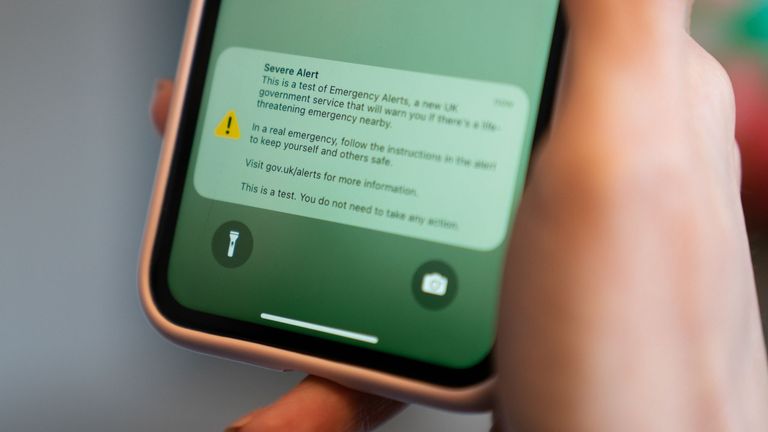Every mobile phone to receive emergency alert: When it will happen - and what it will say
Mobile phones across the UK will be sent an emergency alert as the government tests the system nationwide.

During the test, the second only of its kind, approximately 87 million mobile devices will ring out unprompted.
The system was first tested in April 2023, but the government said some users reported that their phones did not sound, with the problem traced back to specific networks.
It has also been used on several occasions to warn of adverse weather events and in one case last year, when an unexploded Second World War bomb was due to be moved by the military.
Here is what you can expect.
When is it going to happen?
The test is due to happen at 3pm on Sunday 7 September.
Phones will vibrate and emit a loud siren sound for roughly 10 seconds, even if they are set to silent.
A message will also appear on phone screens warning people it is only a test and no action needs to be taken.
The government said it is testing the system to ensure it is working optimally and so the public become familiar with the alerts.
The message is expected to say something similar to the following:
"This is a test of Emergency Alerts, a new UK government service that will warn you if there's a life-threatening emergency nearby.
"In a real emergency, follow the instructions in the alert to keep yourself and others safe. Visit gov.uk/alerts for more information.
"This is a test. You do not need to take any action."
But critics have said the alerts themselves could put people's safety at risk, including drivers who may become distracted and domestic violence victims who keep a secret phone.
Pat McFadden, the chancellor of the Duchy of Lancaster, said the test is "really important" but for those who are in vulnerable positions there is an option to opt out if they want to.
He added: "It'll be a really important moment where we can do the equivalent at a national level of testing the country's fire alarm or smoke alarm. [It is] part of our defences, part of our resilience, and a really important communication tool between the government and the public."
When has the system been used for real?
Since the first national test of the system in April 2023, five alerts have been sent to warn the public of real emergencies.
The largest ever use of the system happened in January this year, when approximately 4.5 million people in Scotland and Northern Ireland received an alert during Storm Eowyn, after a rare red weather warning - meaning there was a risk to life - was issued.
Also in January, the alert warned people of severe flooding at Proctor's Pleasure caravan park near Barrow upon Soar. The message told people in the park to evacuate to a nearby rest centre.
Another alert in December 2024 was sent to approximately 3.5 million people across Wales and the South West of England during Storm Darragh, during which two people died.
The system was used for a non-weather event in February 2024.
An alert was issued by Plymouth City Council to warn local residents to avoid a certain route that was being used to convoy an unexploded Second World War bomb through the city to the sea.
It told residents to stay away from the cordoned area in Keyham for a three-hour window.
Tracey Lee, the chief executive of Plymouth City Council said the government's alert tool was "invaluable" at the time, and allowed the council to reach "thousands of residents instantly".
How does the technology work?
The emergency alerts are broadcast via mobile phone masts and work on all 4G and 5G phone networks.
That's different to how the government sent out lockdown orders during the COVID-19 pandemic, when SMS messages were sent directly to phone numbers.
Despite the government's pleas, domestic violence charities are concerned the alert could give away secret phones people experiencing abuse are keeping hidden.
If you're concerned, it's easy to switch them off.
On iOS and Android devices, search settings for "emergency alerts" and turn off "severe alerts" and "emergency alerts".
On Huawei devices running EMUI 11 or older, search settings for "emergency alerts" and turn off "extreme threats", "severe threats", and "show amber alerts".
The other option is switching off the device entirely or putting it in aeroplane mode before 3pm.
It means whoever sends an alert does not need your number, so it's not something you need to reply to, nor will you receive a voicemail if you miss it. No location or other data will be collected, either.
It also means alerts could be sent to tablets and smartwatches on their own data plans.
Anyone in the range of a mast will receive an alert, and they can be tuned based on geography - for example, Manchester residents would not need an alert about life-threatening flooding in Cornwall.
Manuel Cornelisse, Everbridge's senior director for public warnings, told Sky News the tech had proved its worth in other countries, including his homeland of the Netherlands.
"It's a very well-proven technology with very strong, quality reach," he said.
"And because it's part of the very highest priority of signalling, the service will always remain available, even if a network gets congested when there is massive usage (such as at a sports ground)."
-SKY NEWS






